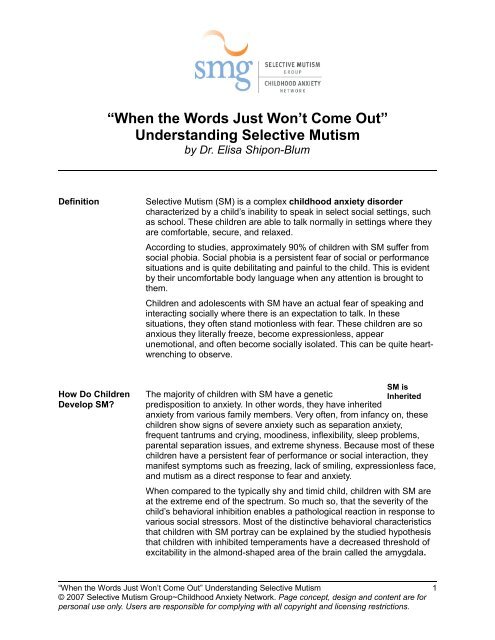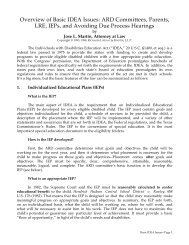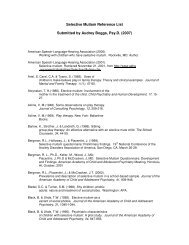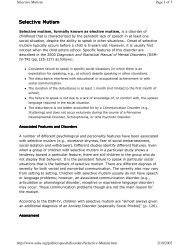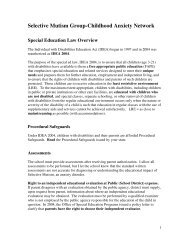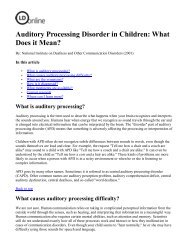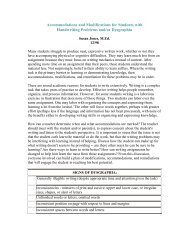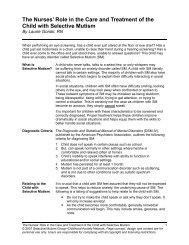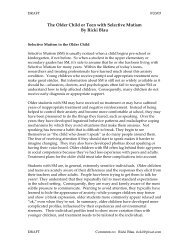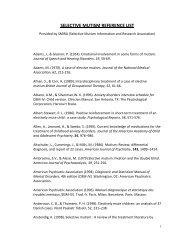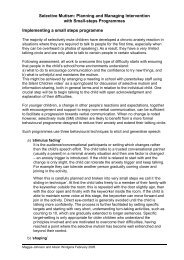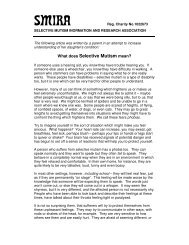When the Words Just Wont Come Out - Selective Mutism Group
When the Words Just Wont Come Out - Selective Mutism Group
When the Words Just Wont Come Out - Selective Mutism Group
Create successful ePaper yourself
Turn your PDF publications into a flip-book with our unique Google optimized e-Paper software.
“<strong>When</strong> <strong>the</strong> <strong>Words</strong> <strong>Just</strong> Won’t <strong>Come</strong> <strong>Out</strong>”<br />
Understanding <strong>Selective</strong> <strong>Mutism</strong><br />
by Dr. Elisa Shipon-Blum<br />
Definition <strong>Selective</strong> <strong>Mutism</strong> (SM) is a complex childhood anxiety disorder<br />
characterized by a child’s inability to speak in select social settings, such<br />
as school. These children are able to talk normally in settings where <strong>the</strong>y<br />
are comfortable, secure, and relaxed.<br />
According to studies, approximately 90% of children with SM suffer from<br />
social phobia. Social phobia is a persistent fear of social or performance<br />
situations and is quite debilitating and painful to <strong>the</strong> child. This is evident<br />
by <strong>the</strong>ir uncomfortable body language when any attention is brought to<br />
<strong>the</strong>m.<br />
Children and adolescents with SM have an actual fear of speaking and<br />
interacting socially where <strong>the</strong>re is an expectation to talk. In <strong>the</strong>se<br />
situations, <strong>the</strong>y often stand motionless with fear. These children are so<br />
anxious <strong>the</strong>y literally freeze, become expressionless, appear<br />
unemotional, and often become socially isolated. This can be quite heartwrenching<br />
to observe.<br />
How Do Children The majority of children with SM have a genetic<br />
Develop SM? predisposition to anxiety. In o<strong>the</strong>r words, <strong>the</strong>y have inherited<br />
SM is<br />
Inherited<br />
anxiety from various family members. Very often, from infancy on, <strong>the</strong>se<br />
children show signs of severe anxiety such as separation anxiety,<br />
frequent tantrums and crying, moodiness, inflexibility, sleep problems,<br />
parental separation issues, and extreme shyness. Because most of <strong>the</strong>se<br />
children have a persistent fear of performance or social interaction, <strong>the</strong>y<br />
manifest symptoms such as freezing, lack of smiling, expressionless face,<br />
and mutism as a direct response to fear and anxiety.<br />
<strong>When</strong> compared to <strong>the</strong> typically shy and timid child, children with SM are<br />
at <strong>the</strong> extreme end of <strong>the</strong> spectrum. So much so, that <strong>the</strong> severity of <strong>the</strong><br />
child’s behavioral inhibition enables a pathological reaction in response to<br />
various social stressors. Most of <strong>the</strong> distinctive behavioral characteristics<br />
that children with SM portray can be explained by <strong>the</strong> studied hypo<strong>the</strong>sis<br />
that children with inhibited temperaments have a decreased threshold of<br />
excitability in <strong>the</strong> almond-shaped area of <strong>the</strong> brain called <strong>the</strong> amygdala.<br />
“<strong>When</strong> <strong>the</strong> <strong>Words</strong> <strong>Just</strong> Won’t <strong>Come</strong> <strong>Out</strong>” Understanding <strong>Selective</strong> <strong>Mutism</strong> 1<br />
© 2007 <strong>Selective</strong> <strong>Mutism</strong> <strong>Group</strong>~Childhood Anxiety Network. Page concept, design and content are for<br />
personal use only. Users are responsible for complying with all copyright and licensing restrictions.
According to studies, when confronted with a fearful scenario, <strong>the</strong><br />
amygdala receives signals of potential danger (from <strong>the</strong> sympa<strong>the</strong>tic<br />
nervous system) and begins to set off a series of reactions that will help<br />
individuals protect <strong>the</strong>mselves. In <strong>the</strong> case of children with SM, <strong>the</strong> fearful<br />
scenarios are social settings such as school, birthday parties, social<br />
ga<strong>the</strong>rings, etc.<br />
Approximately 20-30% of children with SM have subtle speech and<br />
language abnormalities, for example expressive language disorders.<br />
However, <strong>the</strong>se children still have anxiety as <strong>the</strong> underlying cause for<br />
<strong>the</strong>ir mutism. Etiologies for speech and language abnormalities can vary<br />
between immature speech and language development to mild speech<br />
impediments. More studies are necessary to fully access speech and<br />
language abnormalities and SM.<br />
There is a percentage of children with SM who come<br />
from bilingual families, have spent time in a foreign<br />
country, or have been exposed to ano<strong>the</strong>r language<br />
during formative language development (ages 2-4<br />
years old). These children are usually innately<br />
temperamentally inhibited (prone to shyness and<br />
anxiety), but <strong>the</strong> additional stress of speaking<br />
There is no<br />
evidence that <strong>the</strong><br />
cause of SM is<br />
related to abuse,<br />
neglect, or trauma.<br />
ano<strong>the</strong>r language and being insecure with <strong>the</strong>ir skills is enough to cause<br />
an increase in anxiety and mutism.<br />
Behavior It is important to realize that <strong>the</strong> majority of children with SM are as<br />
normal and appropriate as any o<strong>the</strong>r child when in a comfortable<br />
environment. Parents will often comment how boisterous, social, funny,<br />
inquisitive, extremely verbal, and even bossy and stubborn <strong>the</strong>se children<br />
are at home! However, what differentiates children with SM is <strong>the</strong>ir severe<br />
behavioral inhibition and inability to speak in most social settings. These<br />
children feel as though <strong>the</strong>y are “on stage” every minute of <strong>the</strong> day! This<br />
can be quite devastating for both <strong>the</strong> child and parents involved. Often,<br />
<strong>the</strong>se children show signs of anxiety before and during most social<br />
events. Tummy-aches, nausea, vomiting, diarrhea, headaches, and an<br />
array of o<strong>the</strong>r physical complaints are common before school or social<br />
outings.<br />
<strong>When</strong> in school, most children with SM stand motionless and<br />
expressionless and most demonstrate awkward or stiff body language.<br />
Some children turn <strong>the</strong>ir heads, chew or twirl <strong>the</strong>ir hair, avoid eye contact,<br />
or withdraw into a corner. Over time, <strong>the</strong>se children learn to cope in order<br />
to participate in certain social settings. However, <strong>the</strong>y only perform<br />
nonverbally or by talking quietly to a select few. Social relationships are<br />
very difficult for <strong>the</strong> child with SM.<br />
Children with SM have tremendous difficulty initiating any form of<br />
communication and are slow to respond even when it comes to nonverbal<br />
communication. This can be quite frustrating to <strong>the</strong> child as time goes by.<br />
A child with SM will exist nonverbally in various social settings, sometimes<br />
for many years, unless <strong>the</strong>y are properly diagnosed and treated.<br />
“<strong>When</strong> <strong>the</strong> <strong>Words</strong> <strong>Just</strong> Won’t <strong>Come</strong> <strong>Out</strong>” Understanding <strong>Selective</strong> <strong>Mutism</strong> 2<br />
© 2007 <strong>Selective</strong> <strong>Mutism</strong> <strong>Group</strong>~Childhood Anxiety Network. Page concept, design and content are for<br />
personal use only. Users are responsible for complying with all copyright and licensing restrictions.
Characteristics The following are various personality characteristics of children with SM.<br />
<strong>Mutism</strong><br />
Blank facial expressions (when anxious)<br />
Lack of smiling (when anxious)<br />
Staring into space (when anxious)<br />
Difficulty with eye contact (when anxious)<br />
Frozen appearance (when anxious)<br />
Awkward and stiff body language (when anxious)<br />
Difficulty initiating play<br />
Difficulty saying or indicating thank-you, hello, or goodbye<br />
Slowness to respond (i.e., when asked a question, will take longer<br />
than <strong>the</strong> average child to respond ei<strong>the</strong>r verbally or nonverbally. This<br />
is one reason why standardized testing is often difficult and yields<br />
inaccurate results)<br />
Heightened sensitivity to surroundings such as noise, crowds, and<br />
touch<br />
Excessive tendency to worry and have fears (often manifested in<br />
children older than 6 years of age)<br />
Behavioral manifestations at home such as: moodiness,<br />
assertiveness, inflexibility, procrastination, crying easily, need for<br />
control, bossiness, domination, extreme talkativeness, and<br />
expressiveness<br />
Intelligent, perceptive, and inquisitive<br />
Introspective and sensitive (seems to understand <strong>the</strong> world around<br />
<strong>the</strong>m more thoroughly than o<strong>the</strong>r children <strong>the</strong> same age, and portrays<br />
an increased sensitivity to feelings and thoughts, although often have<br />
difficulty expressing feelings)<br />
Manifests artistic interests<br />
As one can clearly see, mutism is just one of <strong>the</strong> many characteristics<br />
that children with SM portray.<br />
Why Such So few understand SM including teachers, <strong>the</strong>rapists, and physicians.<br />
Scarcity in This can be attributed to <strong>the</strong> limited studies and research<br />
Awareness of SM available on <strong>the</strong> topic of SM. Most research results are based on<br />
subjective findings on a limited number of children. In addition, textbook<br />
descriptions are often nonexistent, limited, or information is inaccurate<br />
and misleading.<br />
As a result, few people truly understand SM. Professionals and teachers<br />
will often tell a parent that <strong>the</strong> child is just shy or that <strong>the</strong>y will outgrow<br />
<strong>the</strong>ir silence. O<strong>the</strong>rs interpret mutism as a means of being oppositional<br />
and defiant; where mutism is a means of manipulating and controlling a<br />
situation. Some professionals view SM as a variant of autism or an<br />
indication of severe learning disabilities. For <strong>the</strong> child truly affected by<br />
SM, <strong>the</strong>se assumptions are incorrect, inappropriate, and dangerous!<br />
“<strong>When</strong> <strong>the</strong> <strong>Words</strong> <strong>Just</strong> Won’t <strong>Come</strong> <strong>Out</strong>” Understanding <strong>Selective</strong> <strong>Mutism</strong> 3<br />
© 2007 <strong>Selective</strong> <strong>Mutism</strong> <strong>Group</strong>~Childhood Anxiety Network. Page concept, design and content are for<br />
personal use only. Users are responsible for complying with all copyright and licensing restrictions.
As a result of <strong>the</strong> scarcity and often inaccuracy of <strong>the</strong> information within<br />
<strong>the</strong> literature, children with SM may be misdiagnosed and mismanaged.<br />
In many circumstances, parents will wait and hope <strong>the</strong>ir child outgrows<br />
<strong>the</strong> mutism. However, without proper recognition and treatment, most of<br />
<strong>the</strong>se children do not outgrow SM and end up going through years<br />
without speaking, interacting normally, or developing proper social skills.<br />
Evaluation A trained professional familiar with SM will request a preliminary interview<br />
with <strong>the</strong> parents or guardians of <strong>the</strong> child suspected of having SM.<br />
Emphasis will be on social interaction and developmental history, as well<br />
as behavioral characteristics (including any delays in hearing, speech,<br />
and language), family history (history of family members with anxiety<br />
and/or depression is common), behavioral characteristics (shy<br />
temperament), a description of <strong>the</strong> child and family’s home life, (family<br />
stress, divorce, death, etc.) and medical history.<br />
The professional will often <strong>the</strong>n ask that <strong>the</strong> child attend a session.<br />
Although most children with SM do not speak to <strong>the</strong> diagnosing<br />
professional, <strong>the</strong> professional can spend time with <strong>the</strong> child and attempt<br />
to build trust.<br />
Because 20-30% of children with SM have a subtle abnormality with<br />
speech and language, a thorough speech and language evaluation is<br />
often ordered. In addition, a complete physical exam (including hearing),<br />
standardized testing, psychological assessments, as well as a thorough<br />
developmental screen are often recommended if <strong>the</strong> diagnosis is not<br />
clear.<br />
Diagnoses The average age of diagnosis is between 3 and 8 years old; however,<br />
<strong>the</strong>se children were most likely temperamentally inhibited and severely<br />
anxious in social settings as infants and toddlers. Early on, parents may<br />
notice that <strong>the</strong>ir child is not speaking to most individuals outside <strong>the</strong><br />
home, but may have thought <strong>the</strong>ir children were just “very shy.”<br />
SM usually does not become noticed until <strong>the</strong> child enters school where<br />
<strong>the</strong>re is an expectation to perform, interact, and speak. It is <strong>the</strong>n that SM<br />
becomes apparent and teachers are generally <strong>the</strong> first to identify a<br />
problem. The teacher may become concerned and will tell parents that<br />
<strong>the</strong> child is not talking or interacting with o<strong>the</strong>r children. This can<br />
sometimes be confused with normal and acceptable behavior since most<br />
children have a history of separation anxiety and have been “slow to<br />
warm up.” However, if mutism persists for more than a month, a<br />
parent should seek a help from <strong>the</strong>ir physician or pediatrician and/or<br />
a psychiatrist or <strong>the</strong>rapist who has experience with SM.<br />
“<strong>When</strong> <strong>the</strong> <strong>Words</strong> <strong>Just</strong> Won’t <strong>Come</strong> <strong>Out</strong>” Understanding <strong>Selective</strong> <strong>Mutism</strong> 4<br />
© 2007 <strong>Selective</strong> <strong>Mutism</strong> <strong>Group</strong>~Childhood Anxiety Network. Page concept, design and content are for<br />
personal use only. Users are responsible for complying with all copyright and licensing restrictions.
Importance of Findings indicate that <strong>the</strong> earlier a child is treated for SM, <strong>the</strong> quicker<br />
Early Diagnoses <strong>the</strong> response to treatment, and <strong>the</strong> better <strong>the</strong> overall prognosis. If a child<br />
remains mute for many years, his or her behavior can become a<br />
conditioned response where <strong>the</strong> child literally becomes accustom to<br />
nonverbalization as a way of life. In o<strong>the</strong>r words, SM can become a<br />
difficult habit to break!<br />
The U.S. Surgeon General recently stated that<br />
our country is in a state of emergency as far<br />
as children’s mental health is concerned.<br />
Anxiety disorders are <strong>the</strong> #1<br />
mental illness among children<br />
and adolescents.<br />
Evidence shows that 10% of children suffer from mental disorders, but<br />
less than 5% of <strong>the</strong>se children are actually receiving treatment.<br />
Because SM is an anxiety disorder, if left untreated, it can cripple a<br />
child for life and may curb <strong>the</strong> way for an array of academic, social,<br />
and emotional repercussions such as:<br />
Development of worsening anxiety<br />
Development of depression and manifestations of o<strong>the</strong>r anxiety<br />
disorders<br />
Social isolation and withdrawal<br />
Poor self-esteem and self-confidence<br />
Poor academic performance, school expulsion, or school drop out<br />
Underachievement academically and in <strong>the</strong> work place<br />
Self-medication with drugs and/or alcohol<br />
Crime and involvement with <strong>the</strong> juvenile justice system<br />
Suicidal thoughts and possible suicide<br />
These potential consequences of no or incorrect diagnoses and/or<br />
treatment methods demonstrate <strong>the</strong> importance that <strong>the</strong> main objective<br />
should be to diagnose our children early so <strong>the</strong>y can receive proper<br />
treatment at an early age. This will enable <strong>the</strong>m to develop proper coping<br />
skills and overcome anxiety.<br />
Diagnostic Criteria The Diagnostic and Statistical Manual of Mental Disorders (DSM-IV),<br />
published by <strong>the</strong> American Psychiatric Association, outlines <strong>the</strong> following<br />
criteria for diagnosing SM.<br />
1. Child does not speak in certain places such as school.<br />
2. But, can speak normally in o<strong>the</strong>r settings where he/she is<br />
comfortable and relaxed (often at home).<br />
3. Child’s inability to speak interferes with ability to function in<br />
educational and/or social settings.<br />
4. <strong>Mutism</strong> has persisted for at least 1 month.<br />
5. <strong>Mutism</strong> is not part of a communication disorder such as<br />
stuttering, and is not due to o<strong>the</strong>r conditions such as autistic<br />
spectrum disorders.<br />
Parental Role Parents should remove all pressure and expectations for <strong>the</strong> child to<br />
speak. They should convey to <strong>the</strong>ir child that <strong>the</strong>y understand that he or<br />
she is “scared” to speak and that <strong>the</strong>y will help <strong>the</strong>ir child through this<br />
difficult time. Praise should be given for <strong>the</strong> child’s accomplishments and<br />
efforts, and support and acknowledgment should be given for <strong>the</strong>ir<br />
difficulties and frustrations.<br />
“<strong>When</strong> <strong>the</strong> <strong>Words</strong> <strong>Just</strong> Won’t <strong>Come</strong> <strong>Out</strong>” Understanding <strong>Selective</strong> <strong>Mutism</strong> 5<br />
© 2007 <strong>Selective</strong> <strong>Mutism</strong> <strong>Group</strong>~Childhood Anxiety Network. Page concept, design and content are for<br />
personal use only. Users are responsible for complying with all copyright and licensing restrictions.
Parents should do <strong>the</strong>ir homework and are encouraged to read as much<br />
information as <strong>the</strong>y can about SM. The <strong>Selective</strong> <strong>Mutism</strong> <strong>Group</strong><br />
Childhood Anxiety Network (SMG~CAN) website is a great resource, with<br />
thousands of pages of information to read and print out to educate<br />
o<strong>the</strong>rs. Membership in <strong>the</strong> SMG~CAN community also offers lots of<br />
opportunities for support and interaction with experts and experienced<br />
parents and teachers. It is <strong>the</strong> largest, most comprehensive organization<br />
in <strong>the</strong> world dedicated to SM. (Visit www.selectivemutism.org)<br />
Parents should go with <strong>the</strong>ir instincts and speak with <strong>the</strong>ir family<br />
physician or pediatrician and/or seek out a psychiatrist or a <strong>the</strong>rapist who<br />
has experience with SM. They should ask <strong>the</strong> treating specialist his or her<br />
views on SM as inappropriate treatment methods will only heighten a<br />
child’s anxiety.<br />
Treatment The main goal with treatment is to lower anxiety, increase self-esteem<br />
and increase confidence in social settings. Emphasis should never be<br />
on “getting a child to talk.” All expectations for verbalization should be<br />
removed. With lowered anxiety levels and confidence, verbalization will<br />
eventually follow. A professional should devise an “individualized<br />
treatment plan” for each child.<br />
Treatment usually focuses on a combination of <strong>the</strong> following.<br />
(1) Behavioral Approach: Positive reinforcement and desensitization as<br />
well as removing all pressure to speak techniques are <strong>the</strong> primary<br />
behavior treatments for SM. Emphasis should be on understanding <strong>the</strong><br />
child and acknowledging <strong>the</strong>ir anxiety. Introducing <strong>the</strong> child to social<br />
environments in subtle and non-threatening ways is an excellent way to<br />
help <strong>the</strong> child feel more comfortable. A sample step-by-step “behavioral<br />
approach” plan follows:<br />
1. With few people present at <strong>the</strong> school, <strong>the</strong> parent and child “practice<br />
speaking” in <strong>the</strong> school environment.<br />
2. During a time when o<strong>the</strong>r children are not present, one or two friends<br />
may accompany <strong>the</strong> child at <strong>the</strong> school’s playground to play.<br />
3. During a time when o<strong>the</strong>r children are not present, a small group of<br />
familiar friends may accompany <strong>the</strong> child at <strong>the</strong> school’s playground to<br />
play.<br />
4. Parent(s) will spend time with <strong>the</strong>ir child in <strong>the</strong> classroom.<br />
5. <strong>When</strong> <strong>the</strong> child is speaking quite normally, first <strong>the</strong> teachers, <strong>the</strong>n <strong>the</strong><br />
students, are gradually introduced into a group setting.<br />
6. Only when anxiety is lowered and <strong>the</strong> child feels comfortable and is<br />
obviously ready for some subtle encouragement, positive<br />
reinforcement for verbalization is introduced.<br />
(2) Psychological Approach: Play <strong>the</strong>rapy, psycho<strong>the</strong>rapy, and o<strong>the</strong>r<br />
psychological approaches to treatment can be effective if all pressure for<br />
verbalization is removed and emphasis is on helping <strong>the</strong> child relax and<br />
open up. Confronting mutism in a nonthreatening way is important.<br />
Children with SM are scared; <strong>the</strong>refore, <strong>the</strong> focus should be to help <strong>the</strong><br />
child identify with <strong>the</strong> intensity level of fear in a particular situation.<br />
Helping <strong>the</strong>m to realize that <strong>the</strong>y are understood and are being helped<br />
relieves tremendous pressure.<br />
“<strong>When</strong> <strong>the</strong> <strong>Words</strong> <strong>Just</strong> Won’t <strong>Come</strong> <strong>Out</strong>” Understanding <strong>Selective</strong> <strong>Mutism</strong> 6<br />
© 2007 <strong>Selective</strong> <strong>Mutism</strong> <strong>Group</strong>~Childhood Anxiety Network. Page concept, design and content are for<br />
personal use only. Users are responsible for complying with all copyright and licensing restrictions.
(3) Cognitive Behavioral Therapy Approach: Cognitive Behavioral<br />
Therapy Approach (CBT) helps <strong>the</strong> child modify <strong>the</strong>ir behavior by helping<br />
<strong>the</strong>m redirect <strong>the</strong>ir anxious fears and worries into positive thoughts. CBT<br />
requires <strong>the</strong> incorporation of awareness and acknowledgement of anxiety<br />
and mutism. Most children with SM worry about o<strong>the</strong>rs hearing <strong>the</strong>ir<br />
voice, being asked questions about why <strong>the</strong>y do not talk, or being forced<br />
to speak. Focus should be on emphasizing <strong>the</strong> child’s positive attributes,<br />
building confidence in social settings, and lowering overall anxiety and<br />
worries.<br />
(4) Medication: Studies clearly indicate that <strong>the</strong> best approach to<br />
<strong>the</strong>rapy is a combination of behavioral techniques and medication.<br />
Because most parents are reluctant to start medication immediately,<br />
behavioral techniques are often utilized as a first step in <strong>the</strong> treatment<br />
plan. Duration and success of behavioral treatments alone vary from child<br />
to child. However, if a child does not make adequate progress, medication<br />
is often recommended.<br />
Medication in <strong>the</strong> form of serotonin reuptake inhibitors (SSRIs) such as<br />
Prozac, Paxil, Celexa, Luvox, and Zoloft are very successful in <strong>the</strong><br />
treatment of anxiety disorders. Similar to <strong>the</strong> SSRIs, <strong>the</strong>re are o<strong>the</strong>r drugs<br />
that affect one or more neurotransmitters that are also proven to be<br />
effective. These drugs include serotonin, norepinephrine, GABA, and<br />
dopamine. Examples are Effexor XR, Serzone, Buspar, and Remeron.<br />
Both classes of drugs work well in children that have a true biochemical<br />
imbalance. This seems to be <strong>the</strong> case in <strong>the</strong> majority of children with SM.<br />
Very often, positive effects have been seen in as little as a week!<br />
Medication is used as a “jump start” with <strong>the</strong> hope that, as anxiety is<br />
lowered via medication; behavioral techniques can be implemented more<br />
easily and successfully!<br />
(5) Self-Esteem Boosters: Parents should emphasize <strong>the</strong>ir child’s<br />
positive attributes. For example, if a child is artistic, <strong>the</strong>n by all means,<br />
show off <strong>the</strong>ir artwork! Utilize a special wall to display <strong>the</strong> child’s<br />
masterpieces; perhaps <strong>the</strong>y can even have a special exhibit. They can be<br />
given <strong>the</strong> opportunity to “explain” <strong>the</strong>ir artwork to family members and<br />
close friends. This promotes more verbalization practice, as well as<br />
helping with confidence.<br />
(6) Frequent Socialization: Socialization should be encouraged as<br />
much as possible without pushing <strong>the</strong> child. Frequent play dates should<br />
be arranged with classmates or a small group interaction with individuals<br />
<strong>the</strong> child knows best. The goal should be that <strong>the</strong> child feels comfortable<br />
enough with <strong>the</strong>ir classmates so that verbalization will occur. Most<br />
children with SM will talk to friends in <strong>the</strong>ir own home. As <strong>the</strong> child gets<br />
increasingly comfortable speaking to one child, ano<strong>the</strong>r child could be<br />
included. The group could increase to two or three children at a time. As a<br />
child gets more comfortable with friends, <strong>the</strong>y will hopefully speak to <strong>the</strong>m<br />
at school.<br />
(7) School Involvement: It is necessary for parents to educate teachers<br />
and school personnel about SM. It is imperative that <strong>the</strong> school<br />
understands that children with SM are not being defiant or stubborn by<br />
not speaking, that <strong>the</strong>y truly cannot speak. The teacher should<br />
understand that it is crucial for a child with SM to feel assured that <strong>the</strong>y<br />
will not be expected to speak. Fur<strong>the</strong>rmore, nonverbal communication is<br />
“<strong>When</strong> <strong>the</strong> <strong>Words</strong> <strong>Just</strong> Won’t <strong>Come</strong> <strong>Out</strong>” Understanding <strong>Selective</strong> <strong>Mutism</strong> 7<br />
© 2007 <strong>Selective</strong> <strong>Mutism</strong> <strong>Group</strong>~Childhood Anxiety Network. Page concept, design and content are for<br />
personal use only. Users are responsible for complying with all copyright and licensing restrictions.
acceptable in <strong>the</strong> beginning and should be encouraged. Teachers should<br />
also be involved in <strong>the</strong> treatment plan. As <strong>the</strong> child progresses in his or<br />
her treatment, <strong>the</strong> teacher should encourage verbalization in subtle,<br />
nonthreatening ways.<br />
(8) Family Involvement and Parental Acceptance: A parent’s<br />
acceptance and understanding is crucial for <strong>the</strong> child with SM. In addition,<br />
family members must be involved in <strong>the</strong> entire treatment process. Very<br />
often changes in parenting styles and expectations are necessary to<br />
accommodate <strong>the</strong> needs of <strong>the</strong> child with SM. The child should never be<br />
pressured or forced to speak, this will only cause more anxiety. The child<br />
should feel that parents are <strong>the</strong>re for <strong>the</strong>m and <strong>the</strong>y should receive<br />
special one-on-one time with <strong>the</strong> parent(s). Ideally, this time should be<br />
spent at home in <strong>the</strong> evenings, when all pressure is off, and <strong>the</strong>y feel<br />
most comfortable. The parent can help <strong>the</strong> child relieve stress by<br />
becoming engaged in discussions about <strong>the</strong>ir feelings and allowing <strong>the</strong>m<br />
to “open up.”<br />
It is important to realize that with proper diagnosis and treatment,<br />
<strong>the</strong> prognosis for overcoming SM is excellent!<br />
Contact Contact <strong>the</strong> SMG-CAN for fur<strong>the</strong>r information. Visit<br />
Information www.selectivemutism.org.<br />
The SMG~CAN is a division of <strong>the</strong> nonprofit, 501(c) 3 organization, <strong>the</strong><br />
Childhood Anxiety Network www.childhoodanxietynetwork.org.<br />
“<strong>When</strong> <strong>the</strong> <strong>Words</strong> <strong>Just</strong> Won’t <strong>Come</strong> <strong>Out</strong>” Understanding <strong>Selective</strong> <strong>Mutism</strong> 8<br />
© 2007 <strong>Selective</strong> <strong>Mutism</strong> <strong>Group</strong>~Childhood Anxiety Network. Page concept, design and content are for<br />
personal use only. Users are responsible for complying with all copyright and licensing restrictions.


